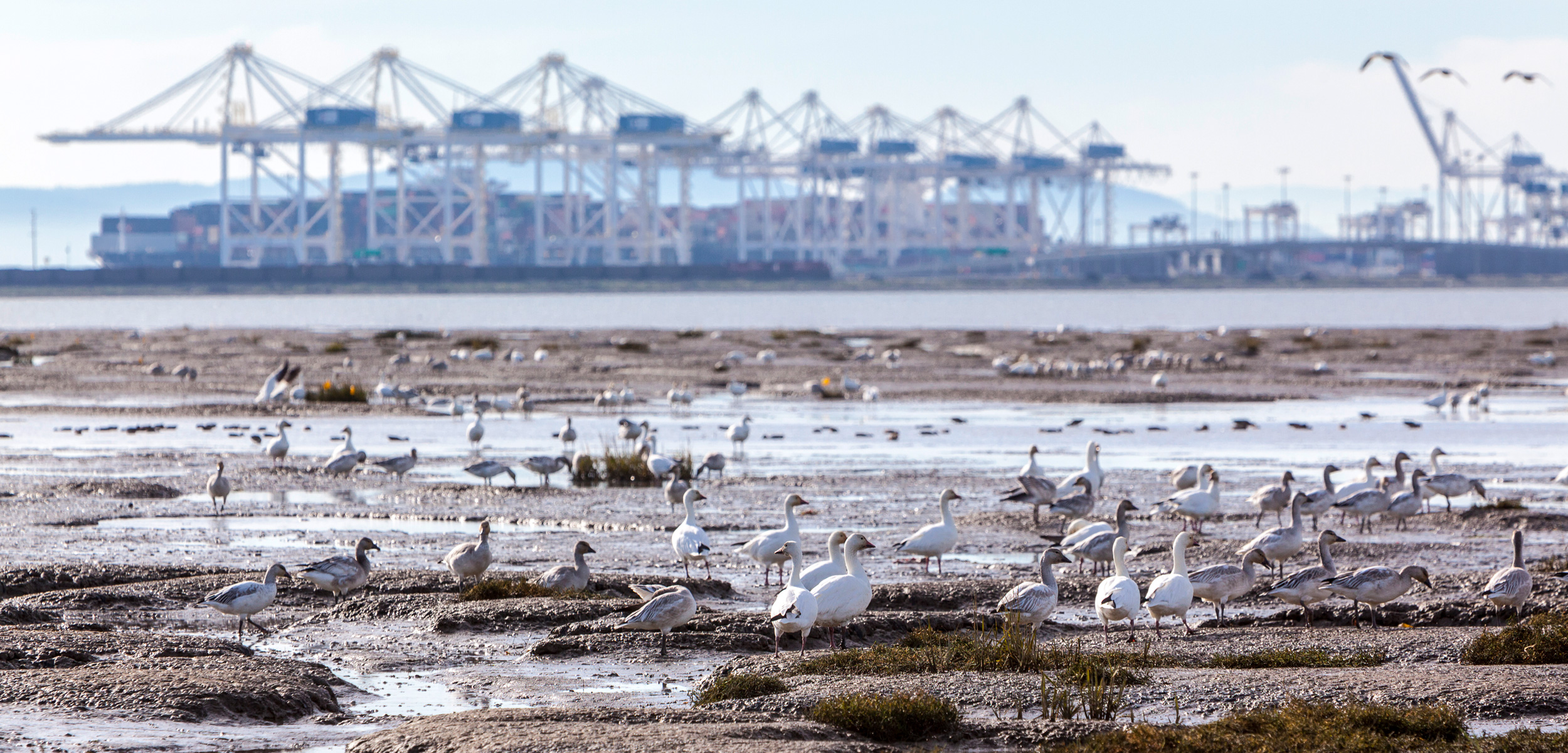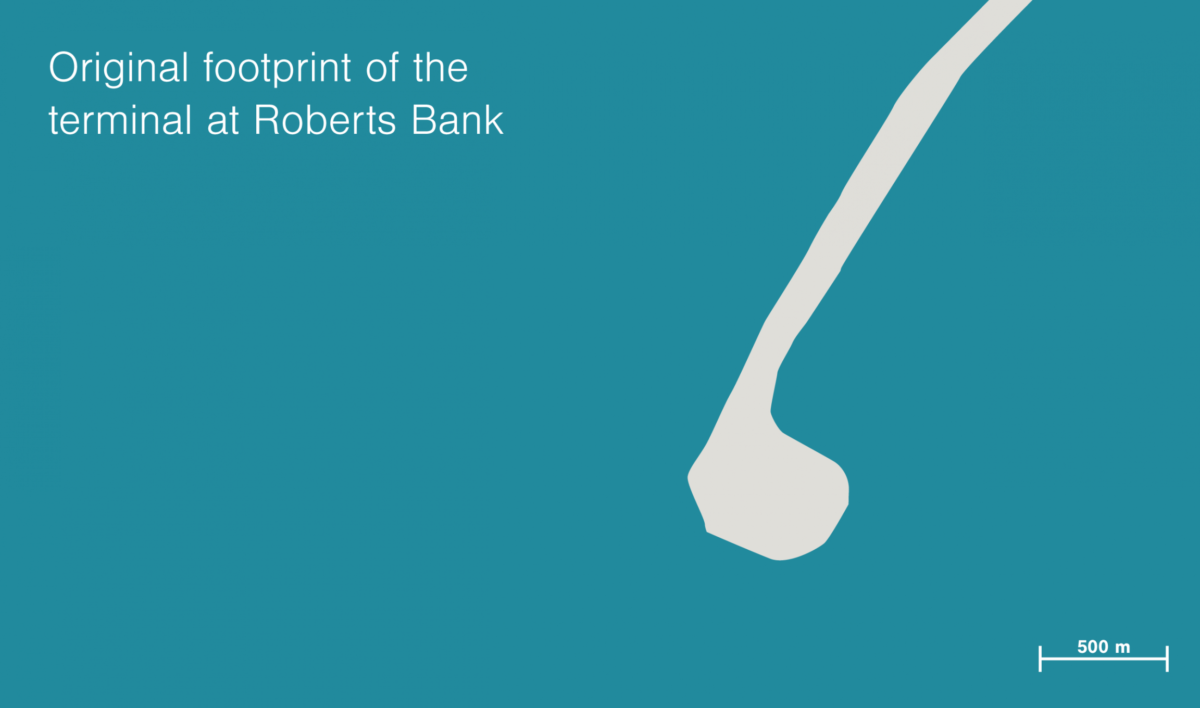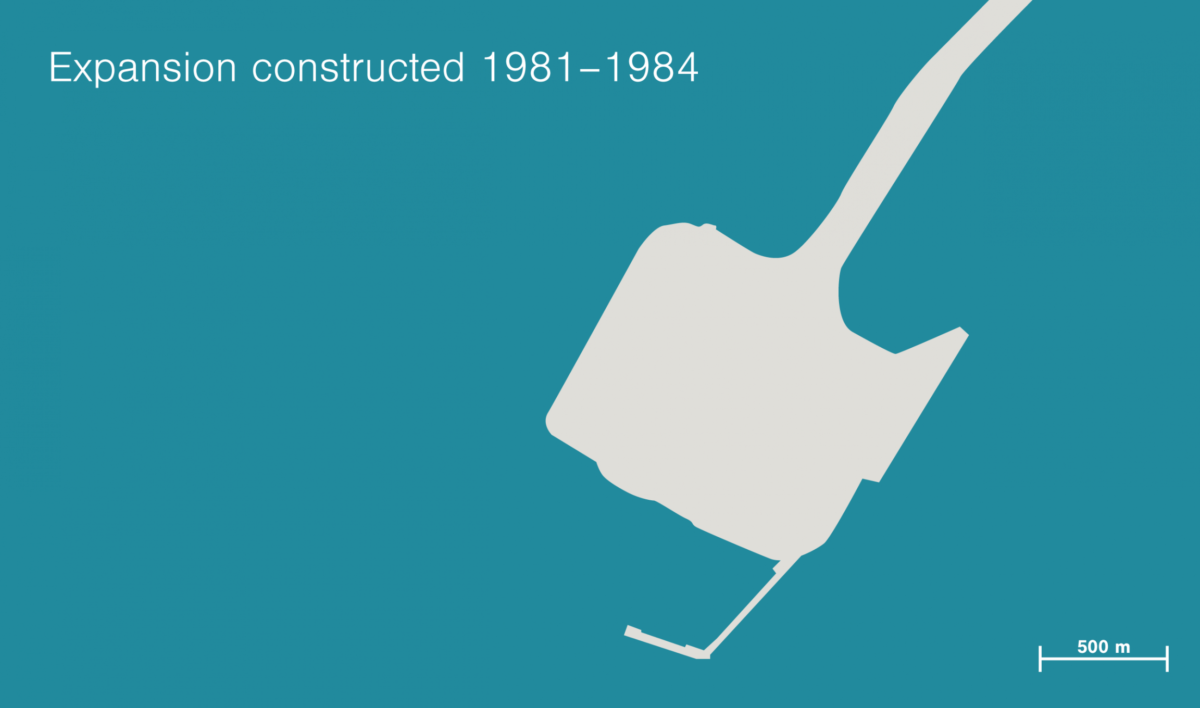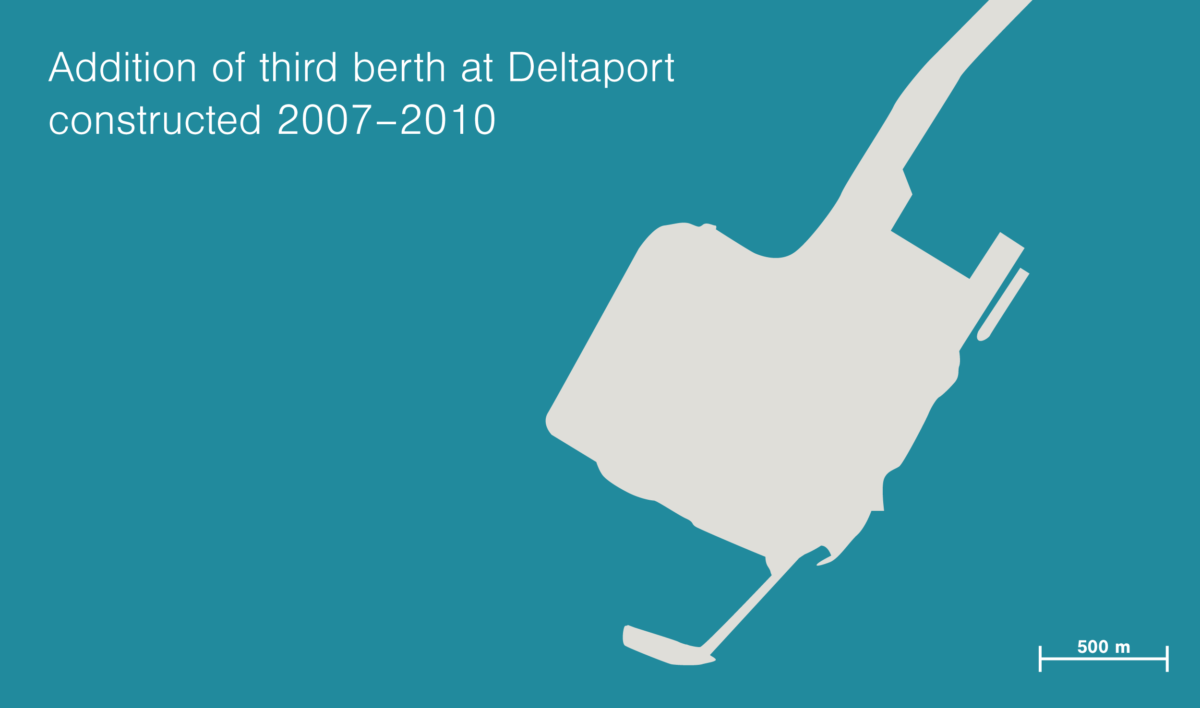The Questionable Science of Vancouver’s Port Expansion
A flawed environmental impact assessment may have consequences for the western sandpiper.
Article body copy
 This article is the second in a two-part series. The first installment was “Slime, Shorebirds, and a Scientific Mystery.”
This article is the second in a two-part series. The first installment was “Slime, Shorebirds, and a Scientific Mystery.”
Congratulations to Amorina Kingdon on being named Best New Magazine Writer from the National Magazine Awards for this article.
The container ship Hyundai Splendor is 340 meters in length, about as long as the Eiffel Tower is high. On a late August afternoon, it sits in a berth at a massive container terminal rising from British Columbia’s Roberts Bank, an hour’s drive south of Vancouver. White gantry cranes hover over the Splendor’s containers like birds waiting to peck morsels. In the distance, a train loaded with containers stretches down a four-kilometer causeway to the shore. Ports have long been hotbeds of intrigue, and this terminal, Deltaport, its industrial structures silhouetted against the sky, looks like something from the Michael Mann movie Heat. Robert De Niro could be hiding behind a crane hunting for Al Pacino.
The Hyundai Splendor arrived right on schedule last night, docking just before midnight under the glare of 24/7 lighting. The Splendor and other container ships travel long distances between stops, sticking to set routes and schedules, just like migrating birds. Splendor sails a route called North Pacific 3, setting out from Qingdao, China, on the Yellow Sea, and calling at the Chinese ports of Ningbo and Shanghai, and the South Korean port of Pusan. Then, loaded with clothes and iPads and other consumer goods, it crosses the Pacific to Deltaport. After unloading, the terminal’s cranes lift aboard containers of wood pulp, lumber, and lentils, and the ship heads back to Qingdao.
Deltaport is Canada’s largest container terminal and integral to the Vancouver Fraser Port Authority, also known as the Port of Vancouver, a crown corporation whose 27 terminals in Metro Vancouver generate CAN $9.7-billion in direct gross domestic product. And although the port already has four container terminals, it now wants to expand at Roberts Bank. If this development at the southernmost edge of the Fraser River delta—known as Terminal 2—goes ahead, the cranes could soon be loading four or five container ships at a time instead of two, making Roberts Bank one of the busiest container shipping hubs in North America.
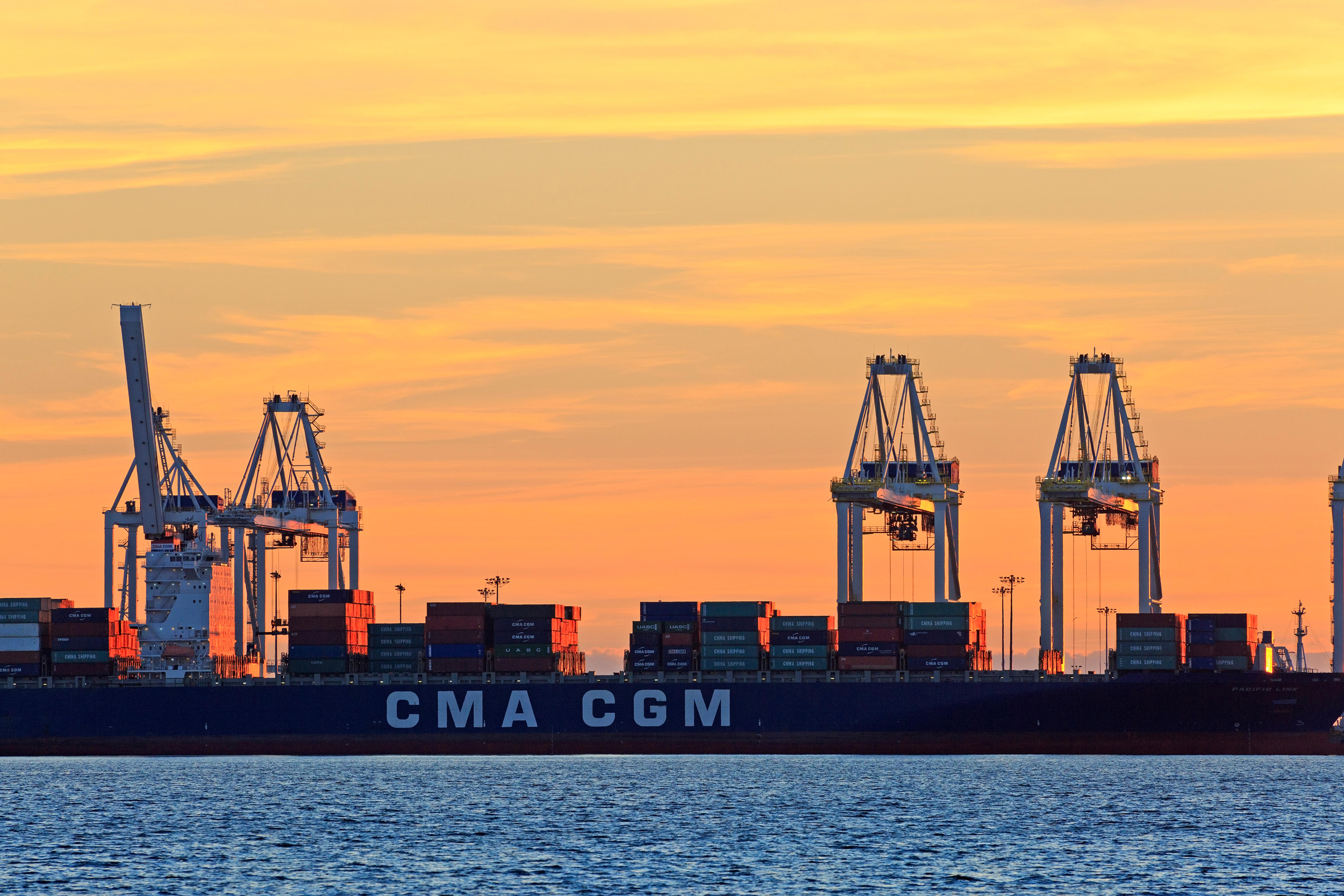
Huge gantry cranes unload containers from the large ships that call at Deltaport. Such containers can be moved easily between ships, rail lines, and trucks, and they can carry goods ranging from iPads to sneakers to wood pulp. Photo by Keith Douglas/Alamy Stock Photo
But as biologists and birdwatchers know all too well, the delta is already one of nature’s critical transportation hubs. Recognized by an international treaty as a vital wetland, the Fraser delta plays host to millions of migrating birds each year. Gulls and snow geese, dunlin and coots all pass through the estuary’s 22,000 hectares, each seeking its preferred habitat. Some flock to the marshes, others to the water or the fields. But one species, the western sandpiper, is particularly picky about where it sets down in the spring. It largely gravitates to a relatively small patch of mudflats on Roberts Bank, just to the north of Deltaport’s long causeway. Here it feeds on insects, worms, crustaceans, and a snot-like substance called biofilm, the true ecological value of which scientists are still trying to understand.
Birds and boats have managed to coexist for decades on Roberts Bank. But Terminal 2 would be the largest port expansion to date and it’s very close to where huge numbers of western sandpipers flock to feed on biofilm. Exact counts vary year to year, but scientists have counted an estimated half a million sandpipers in one day on the flats, and most of the estimated 3.5 million western sandpipers in the world stop to feed at the Fraser River estuary at some point in their life. So decisions about the expansion won’t just affect a few birds: they’ll affect a species. Scientists who have spent their careers studying these ecosystems say that a much clearer understanding of the mudflats at Roberts Bank is needed before regulators make any decision. “The best thing to do is not do anything until we understand it more,” says ecologist Patricia Baird, a research associate at Simon Fraser University in Burnaby.
The proposed development at Roberts Bank has triggered a contentious environmental assessment, and a federal joint review panel in Canada is now deliberating whether a massive new container terminal is “likely to cause significant adverse effects” to the environment. The assessment process is long, expensive, and adversarial, and the question of how the sandpipers and biofilm could be impacted has become a point of contention. Port officials say that scientific studies—many of which it funded—show that the birds will be just fine. Citizen groups accuse the port of bad science. And the 7,000-page environmental impact statement that’s supposed to provide scientific evidence instead offers conflicting data and few clear answers, as knowledge of biofilm and birds keeps evolving.
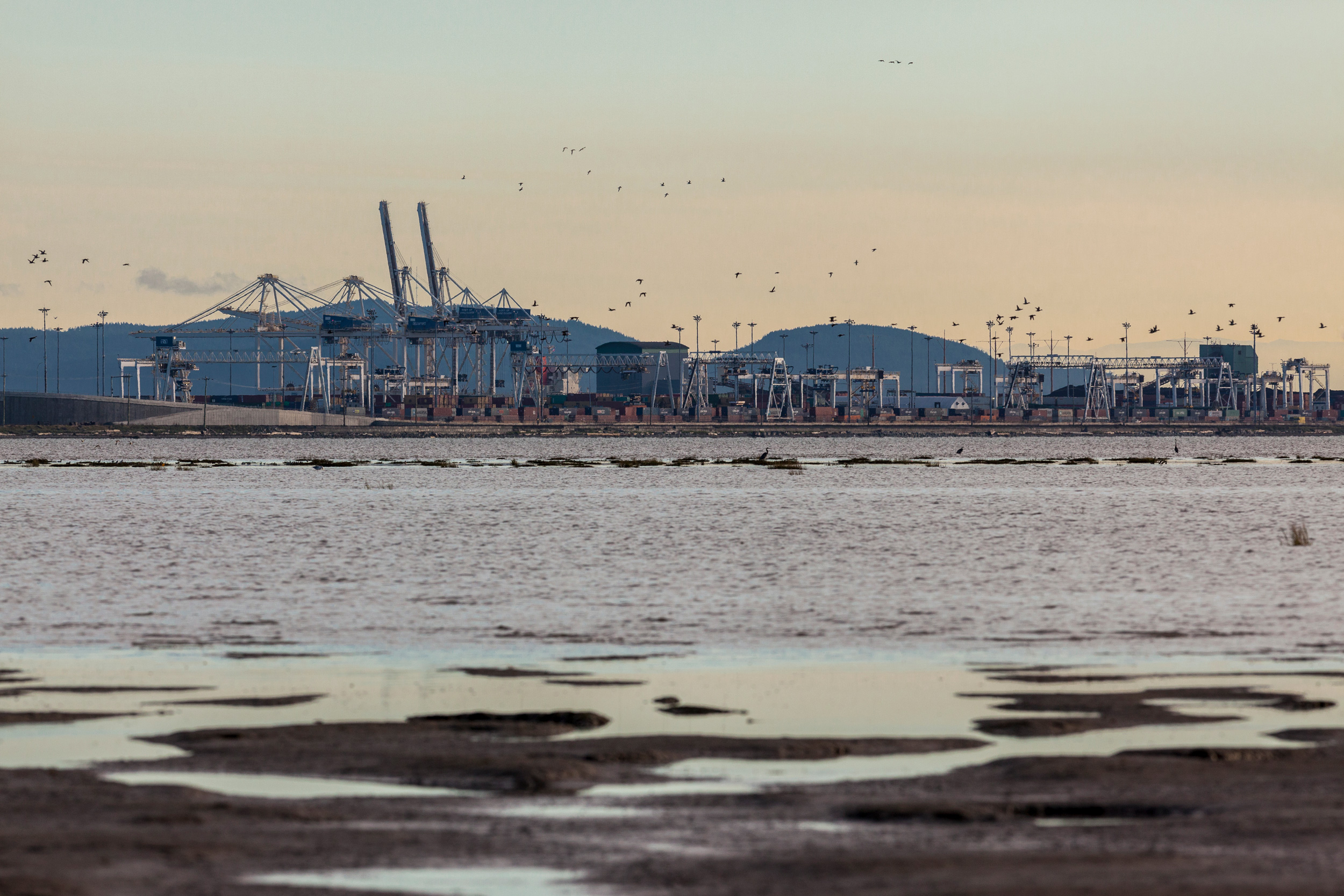
Deltaport operates 24 hours a day, seven days a week. The cranes unload containers packed with consumer goods, mostly from China. They are bound for Canadian and American consumers. Photo by Ron Watts
Terminal 2 has become a thicket of thorns—industry, money, and science. Finding a path through this thicket will depend on how decision-makers weigh the scientific evidence, and how they treat ecosystems we’ve yet to fully understand. Getting this path right is critical because, as one federal agency has noted, the decision “could have species-level consequences.”
Rob Butler hears a peep. He stops mid-sentence and scans a patch of blue water glittering in a marsh to the north of Roberts Bank and the proposed site for Terminal 2. He listens intently. Butler is an ornithologist. He’s also president of the Pacific WildLife Foundation, a charitable organization devoted to coastal and marine research and education. At the moment, the two of us are perched six meters up a wooden birdwatching tower. A straw Panama hat shades Butler’s eyes from the relentless summer sun.
“There!” he says, pointing. “See them?”
I stare, but I don’t see anything at first. Then I see a knot of sandpipers, 20 at most, flying at incredible speed. They soar with fierce intensity, darting like fighter jets. They never collide: each bird constantly adjusts its position relative to its neighbors and the flock moves as one, a system more than the sum of its parts.
It’s August, and these birds are juveniles heading south. Three months ago, they were born on the Arctic tundra during near-constant daylight, under the care of both parents. Their moms left first, winging south to Panama around the summer solstice. Dads followed in July, trailed a month later by the juveniles. This southward migration is slower and the flocks are smaller than the urgent northward springtime journey to breed. Butler’s voice quickens, recalling the sound the sandpipers made as they flocked en masse to the mudflats in April. “It was just like a jet engine,” he says. He pauses and grins, reaching for a metaphor. “All those hearts beating away.”
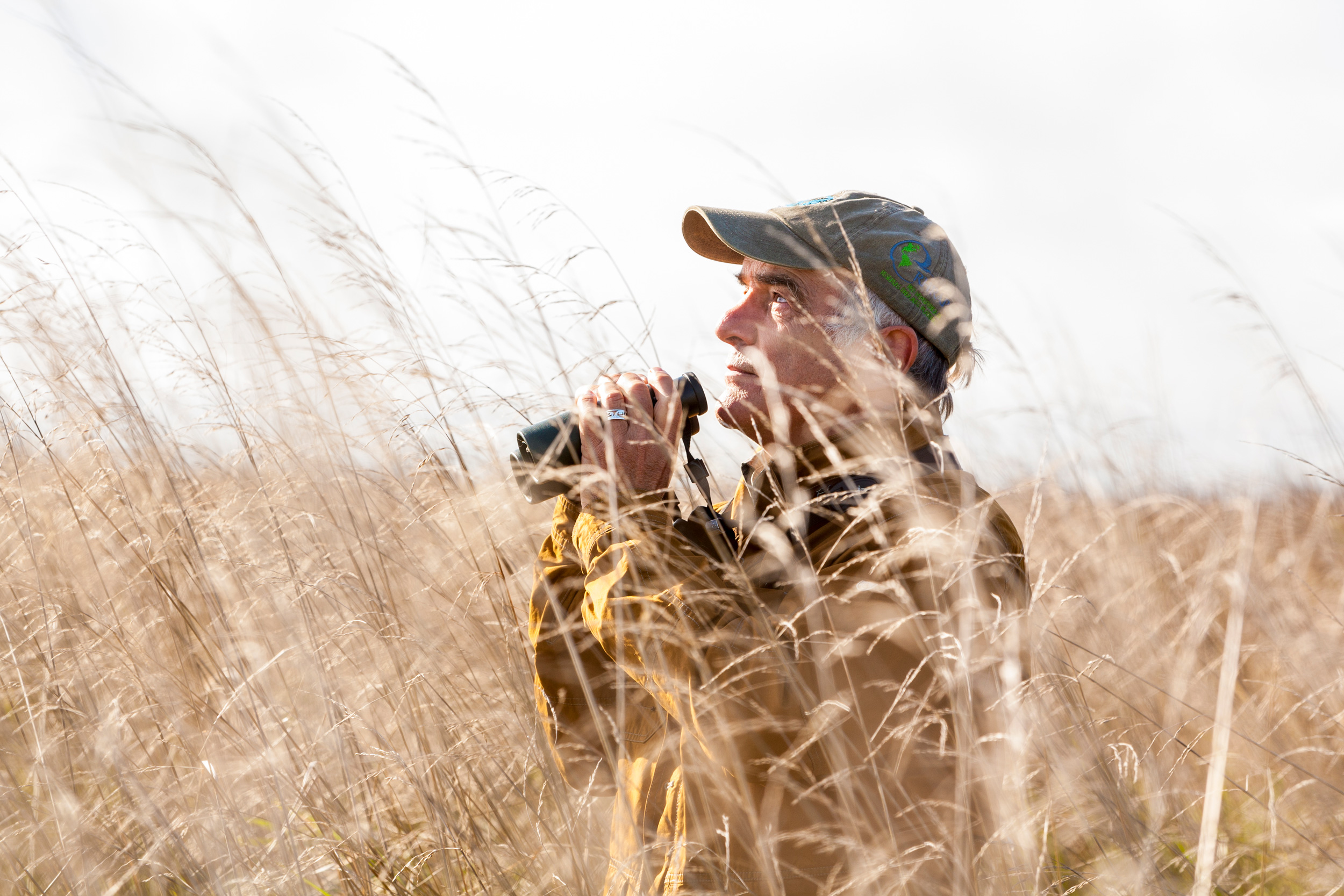
Canadian ornithologist Rob Butler has studied western sandpipers and other migratory birds for decades. He says their survival depends on healthy estuarine ecosystems. “No bird is an island,” Butler notes. Photo by Ron Watts
Butler has studied birds for 40 years. Now, wandering through the shaded paths and open marshes of the George C. Reifel Migratory Bird Sanctuary just north of Roberts Bank on Westham Island, he points out the bird species around us with the familiarity and enthusiasm of greeting old friends. He’s amazed by the natural phenomena that synchronize to make their migration possible.
Migration, he explains, is a balancing act between resource and risk. Western sandpipers achieve this equilibrium by spending winters in Mexico and Panama, where the sheer abundance of food makes up for the presence of predators. But, as the days grow longer in spring, they head north to the Arctic, which is rich in tasty insects and relatively predator-free—perfect for nesting. On this northward spring migration, they follow a chain of coastal stops: food-rich estuaries, deltas, and tidal marshes. After the Fraser, some touch down along the Stikine River delta in southeast Alaska, but many do the final 2,000 kilometers of ragged green coast in one go, with no sleep until the Copper River Delta in the Gulf of Alaska.
For small birds that weigh little more than a few coins, these migrations are the ultimate test of endurance. No marathon, no ultramarathon, comes close to these journeys along a continent’s worth of coastlines. “In some respects,” Christopher Guglielmo, a biologist at the University of Western Ontario, writes in a recent paper, “a journey to the moon” seems like a more appropriate metaphor.
Today, scientific research shows that the western sandpiper’s successful migration depends on that snot-like substance, biofilm.

Each year, more than a billion birds migrate along the west coast of North America, on a route scientists have dubbed the Pacific Flyway. Major stopovers for the western sandpiper include the Copper, Fraser, and Stikine River deltas, and San Francisco Bay. Illustration by Mark Garrison
Patricia Baird has spent much of her career studying marine birds and shorebirds. She is short and slight, but as our conversation turns to the subject of tagging migratory birds (“her birds”), her energetic, rapid-fire speech makes her seem larger than she is. Baird has long studied how nutrients cycle between land and sea, and in 2004, she began studying western sandpipers. She’s since followed the complex, evolving science of birds and biofilm.
On Roberts Bank, she explains, a gooey film forms on the mudflats, mostly made up of single-celled, photosynthetic marine organisms called diatoms. Each year, in March and April, sunlight, warmth, and the first pulse of nutrient-rich water from the spring freshet in the Fraser delta triggers diatoms to “bloom,” or reproduce, for a few weeks. And as they bloom, they produce long-chain essential fatty acids (LCEFAs). Diatoms are one of the few organisms on Earth that can synthesize these fatty acids: most other life forms absorb these important fuel sources from food.
At first, scientists thought western sandpipers just ate biofilm for its caloric value, a kind of migration energy drink. But Baird and many other researchers now think the birds need this goo because of the type of essential fatty acids it contains. “These acids are essential for growth and development,” Baird says. They help with reproduction and fat storage, and they transform birds’ flight muscles, increasing their endurance for these moonshot migrations. And western sandpipers aren’t the only shorebirds that target LCEFAs. Migrating red knots hoover up fatty-acid-rich horseshoe crab eggs in the eastern United States, while semipalmated sandpipers gobble fatty-acid-rich amphipods on Canada’s east coast.
Western sandpipers seem to eat biofilm in very particular places, exactly where probably depends in part on physical limitations. They have special bristles on their tongues to scoop up this gunk, and these bristles work better on some parts of Roberts Bank than they do on others. On the birds’ favorite mud swath near the Deltaport causeway, the sediment is fine, dense, nearly dry, coal-black mud—allowing easy scooping of biofilm. (Imagine licking cream from an Oreo cookie versus a crumb cake.) The water depth there seems important, too. Given the length of their beaks and legs, Baird says, the birds need to feed in shallow water, and near the shore. And—and this is where the science is still in progress—different kinds of biofilm form in different places, and the Roberts Bank patch seems to have the good stuff.

Western sandpipers migrate thousands of kilometers between their summer breeding grounds in the Arctic and their winter feeding grounds in Mexico and Central and South America. Photo by Matthias Breiter/Minden Pictures
Roberts Bank is prime real estate for the western sandpipers. But it is also prime real estate for Metro Vancouver’s port operations, and this has led to a conflict that is now decades old.
In 1968, Canada’s National Harbours Board began building an island up from the seafloor on the southwest edge of Roberts Bank, where the water was deep enough for coal ships. Over the next year, a massive smear of gray-brown rock and sand emerged from the water. Then a slim causeway from the mainland grew and connected to the island, tethering it to shore. The National Harbours Board declared the causeway finished on April 8, 1969, and in 1970, a new coal shipping facility, Westshore Terminal, opened. It was an era when environmental assessments were not required.
Soon after, in 1975, the National Harbours Board proposed an expansion to the coal terminal, turning the 20-hectare island into about a 130-hectare one, an increase of 650 percent. A federal panel was called to review the proposed expansion, and turned it down. In the decision, the panel said that Roberts Bank was located in one of the most ecologically important estuaries in North America, and the panel members “concluded that significant environmental damage and risk would result from the proposal.” Despite this red flag, the National Harbours Board won approval for a smaller expansion to the coal terminal in 1981, completing it by 1984. And in 1992, the Vancouver Port Corporation, which succeeded the National Harbours Board, proposed a new two-berth container terminal—Deltaport.
Container traffic was booming at the time, and the port wanted more berths to handle it. Containers had revolutionized cargo shipping by creating one standard unit that moved easily from ship to truck or rail. And so essential were these metal boxes becoming to international transportation that entire industries were redesigning their products so they could be shipped in containers. But despite the ecological concerns raised by the 1979 federal panel, no new federal environmental review panel was convened for Deltaport, and no studies on animals or plants were done. Deltaport was completed in June 1997.
Six years later, the Vancouver Port Authority (as it was then called) proposed building a brand-new container facility, Terminal 2, as well as a third berth at Deltaport. But these proposals were met with stiff opposition from the community and from Environment Canada, which noted that “the chain of the Pacific Flyway could be broken for shorebirds at some point, given the ongoing economic development in the delta.” So the authority withdrew its Terminal 2 proposal, citing the need for more consultation with the community. But that withdrawal may have been strategic. By putting Terminal 2 on hold, the authority’s plan for a third berth at Deltaport could proceed without an assessment of cumulative effects—a long, costly additional analysis in which the effects of multiple projects in a given location are considered together.
Finally in 2013, officials at the (renamed) Vancouver Fraser Port Authority submitted a new proposal for Terminal 2 to the Canadian Environmental Assessment Agency (CEAA), stating that the port needed this expansion to meet the rising demand for container capacity.
This map shows the gradual expansion of Roberts Bank over time. Illustration by Mark Garrison
Canada’s federal environmental assessment process takes years of work, millions of dollars, and, sometimes, very delicate public relations. The process begins when a proponent submits a description of the project they want to build to the CEAA. The agency then decides if the project needs an environmental assessment, and, if so, who will handle it—either CEAA itself or a review panel, which often handles very complex or contentious projects. The proponent then does research and produces an environmental impact statement (EIS) that examines the evidence of potential negative impacts. At each stage, the public has a chance to comment. Finally, the CEAA or the review panel writes a report recommending a thumbs up or down. The minister of Environment and Climate Change Canada makes the final decision.
When it proposed Terminal 2 for the second time, the Port of Vancouver decided to get a head start on the process. Even before it submitted a project proposal for Terminal 2, it convened in 2012 four technical advisory groups (TAGs) composed of independent scientists who possessed expertise on scientific topics that would likely be controversial. Each TAG was asked to submit a report that would help design the EIS and its constituent studies.
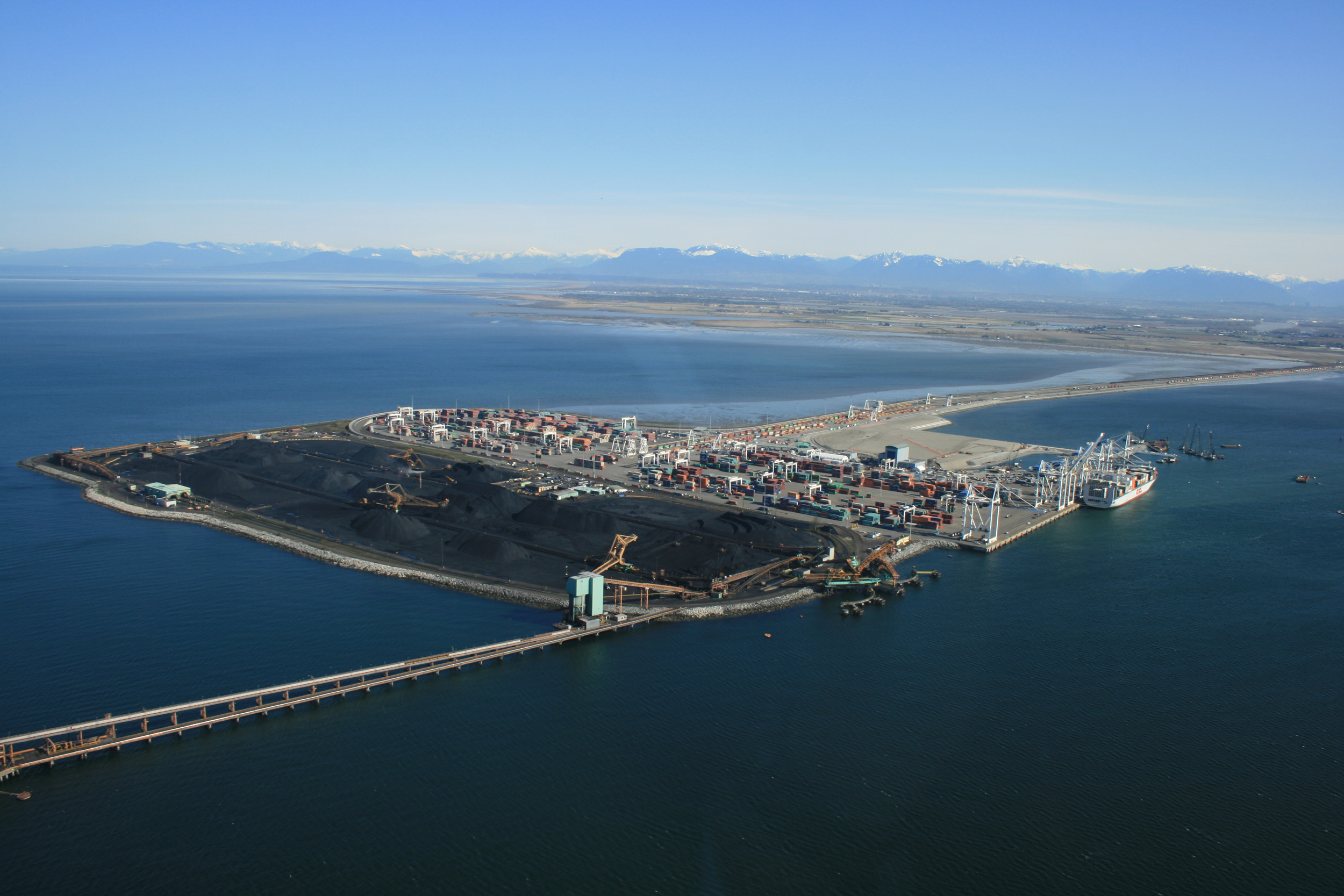
Occupying an artificial island five kilometers offshore, the container terminal of Deltaport was opened in 1997. Since then, the terminal has grown in area. If approved, Terminal 2 would be the largest expansion to date. Photo courtesy of the Government of Canada, Asia-Pacific Gateway and Corridor Initiative
The biofilm and shorebirds TAG consisted of 28 people; 18 worked for the port or its contractors and the rest were either independent scientists or researchers with other government agencies. Some of these scientists had published peer-reviewed studies on the relationship between sandpipers and biofilm, and Mark Drever, an Environment Canada biologist who served on this TAG, says the discussions were collegial, well moderated, and never felt restricted.
In 2013, the biofilm and shorebirds TAG issued a report that, among other things, advised the port to undertake two follow-up studies. One of the studies, it stated, should investigate “the role of fatty acids in diet and the palatability of biofilm to understand shorebird preference for different biofilm types.” This was a new area of research in 2013, but the TAG recognized that it was potentially important to consider fatty acids in assessing the possible impact of Terminal 2.
Once the TAGs were done their work and the proposal submitted, the field studies required to complete the EIS began. The port funded dozens of these projects, which were conducted by private environmental consulting firms such as WorleyParsons and Hemmera. In all, the fieldwork required more than 35,000 hours of labor. The studies were written up as technical reports, a standard practice for environmental assessments. One of these reports measured biofilm’s lipid content throughout the year and across the mudflat, and another compared the proportion of biofilm to other prey in the sandpiper’s diet, but none of the studies seem to have looked at the role of long-chain essential fatty acids.
In March 2015, the port published its much-anticipated 7,000-page EIS. Just reading the statement cover to cover would have taken an average person nearly 120 hours, not including the time needed to check the references, many of which were behind the paywalls of academic journals. And there was another obstacle. The EIS was posted on March 27, 2015, and public comment was required by June 15—less than two months later. Even if people started reading right away in March they would have had to absorb three hours of dense, university-level science a day, every day. There is a 124-page executive summary, but only three pages address biofilm, and they provide only summary statements, not data.
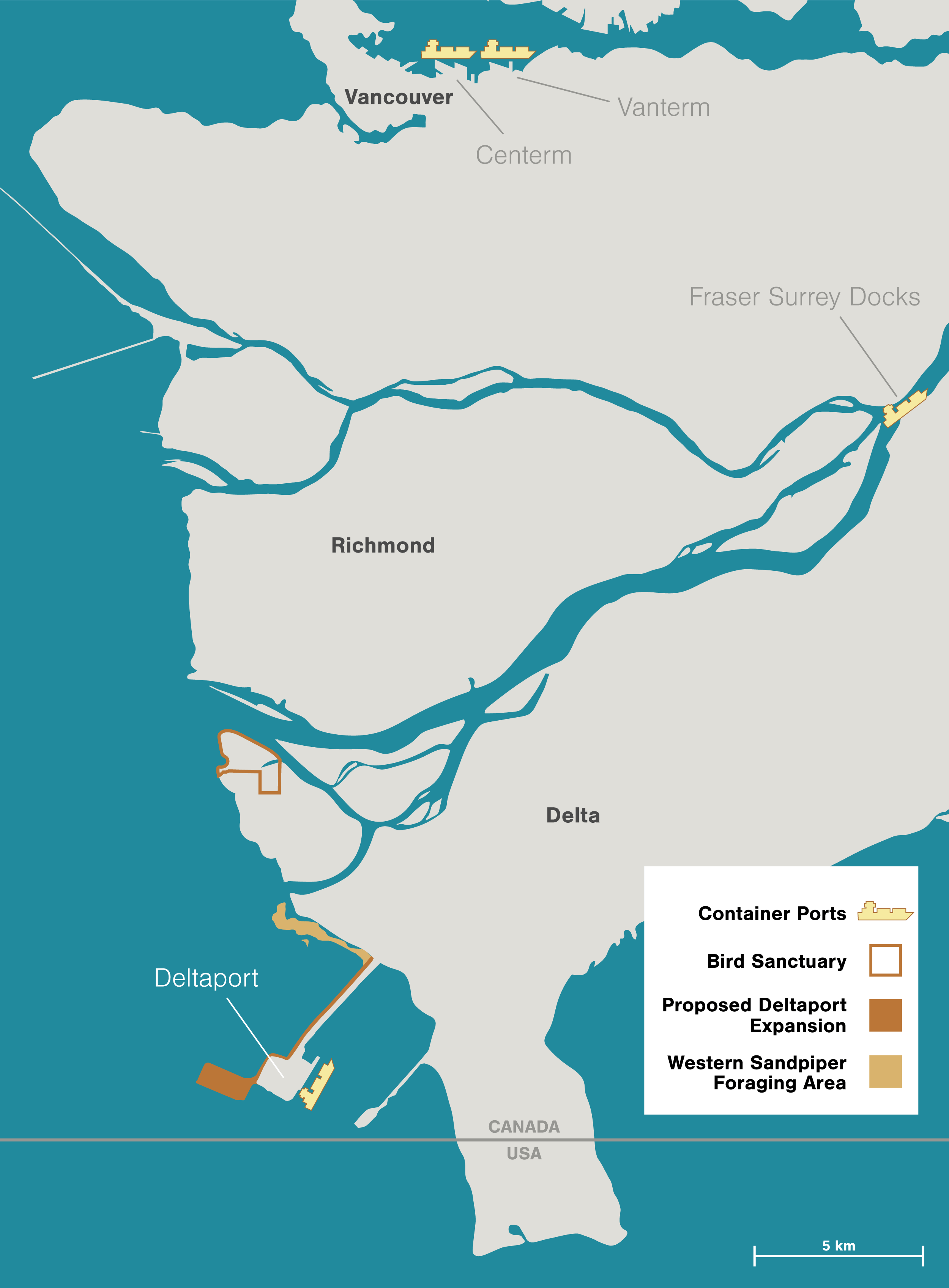
The Port of Vancouver owns four container terminals scattered across Metro Vancouver. But the port, a crown corporation, argues that it needs more berths to accommodate future container traffic. It says that Vanterm and Centerm in Vancouver both lack room for future growth, while the Fraser Surrey Docks are limited by the depth and width of the Fraser River. Illustration by Mark Garrison
The EIS made a simple but powerful observation, however: it noted that the science of biofilm was still very new. One table stated that it was important to study biofilm because data was limited and it was still unclear how it fit into the ecosystem. Another section noted that the “long-term trends are unknown. No long-term dataset exists for biofilm at Roberts Bank.”
But despite the limited data, the EIS weighed in on whether Terminal 2 would affect the biofilm of Roberts Bank. It began by dividing biofilm into two types: that dominated by marine diatoms, and that dominated by diatom species that thrive in fresher, riverine water. The EIS then suggested that the construction of Terminal 2 would change the flow pattern over Roberts Bank—a worrying prediction because this would alter both the distribution and proportions of the types of biofilm there. Diatoms that prefer fresher water do produce fatty acids, but, according to research, the types and amounts of fatty acids they produce may be different than those produced by marine diatoms.
Computer modeling maps showed that water salinity would decrease north of the causeway and that the marine biofilm on the sandpipers’ favorite mud swath would diminish. However, freshwater biofilm would spread with a new patch forming farther out. Based on this, the EIS concluded that the net amount of biofilm wouldn’t change, and that Terminal 2’s effect on biofilm would be negligible. It viewed the two types of biofilm as interchangeable food sources for the birds, despite their varying content and location.
Would the western sandpipers eat biofilm that formed in fresher water? Are they physically capable of slurping it up farther out on the bank? And would diatoms in freshwater biofilm produce the essential fatty acids the birds need? These are the areas that need further study, the TAG suggested. But the EIS doesn’t mention the lipid data from that one technical report, and the words “fatty acid” and “lipid” do not appear in either the EIS’s biofilm or shorebirds chapter. Biofilm is considered solely in terms of amount, in part because the ecological model underpinning the EIS looks only at the metrics of biomass and productivity.
The EIS also muddied the water on the question of whether these potential changes in the biofilm’s makeup are “significant.” It states that there are no known standards to determine how significant these effects would be to biofilm, and that they relied on “professional judgment and current scientific knowledge.” Yet the biofilm chapter concluded that there were no significant adverse residual effects on biofilm. Baird and others wonder how the report could be so confident, given the lack of understanding about the ecosystem. “If they don’t have a way to figure out whether it’s significant, they obviously don’t understand how it works,” Baird says.
Environment and Climate Change Canada agrees. In its submission to the joint review panel, the federal agency noted that no study to identify the vital lipid-producing diatom species had been conducted, and it disputed the EIS’s claim that any likely impact on the biofilm would be temporary. Indeed, the federal agency stated that the impacts of Terminal 2 on the biofilm would likely be “irreversible,” and it concluded that “there are substantive issues, omissions, and uncertainties” in the EIS.
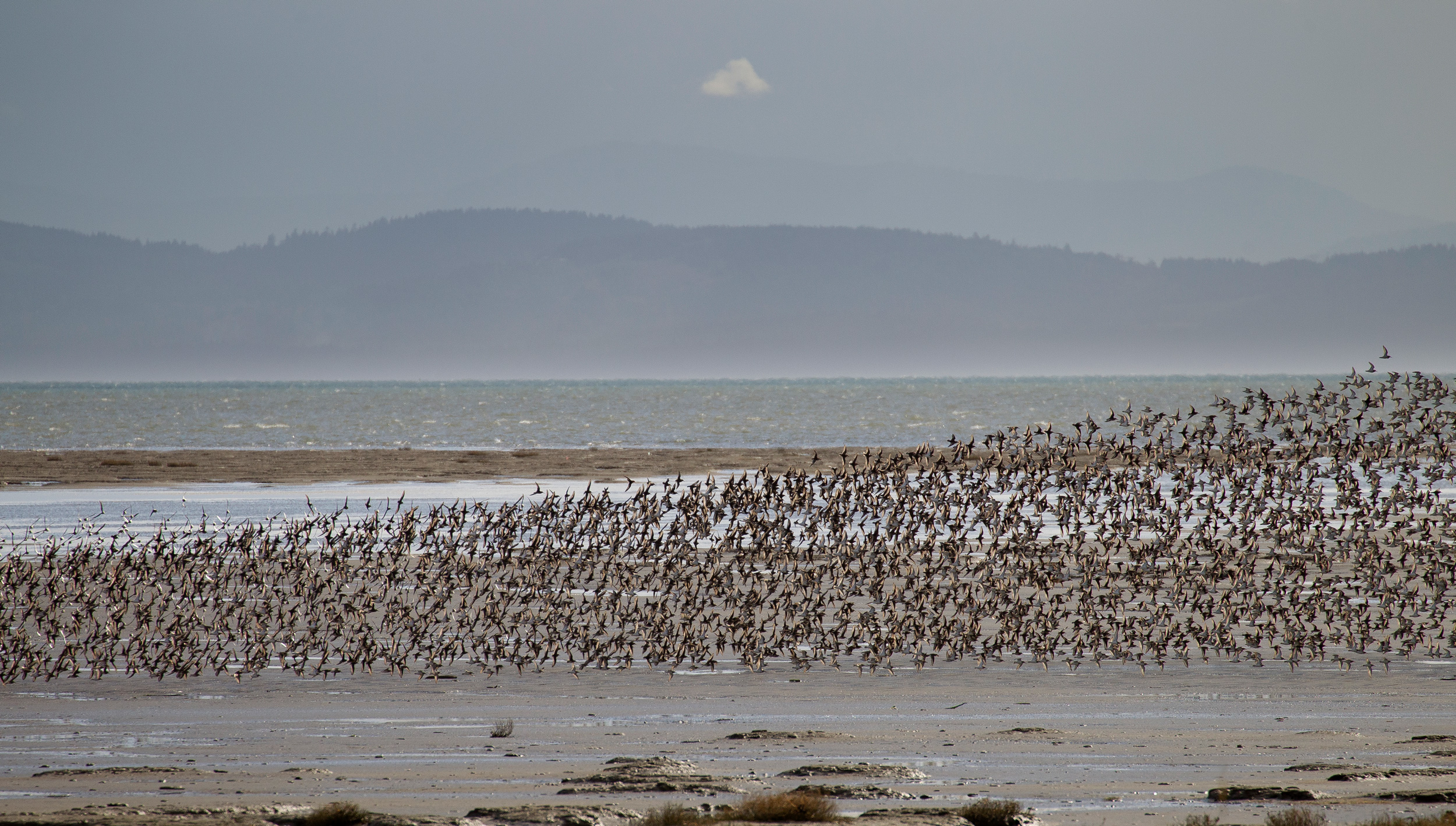
Hundreds of thousands of western sandpipers alight on Roberts Bank in April and May during their northward migration. Many of these birds gravitate to one small corner of Roberts Bank to feed on biofilm. Photo by Matthias Breiter/Minden Pictures
And, in the view of critics, there was one last troubling problem. The EIS didn’t look at what would happen to the migrating birds after they left the waters that would be affected by Terminal 2. It could be argued, very persuasively, that the port is not responsible for considering the cumulative effects of industrial projects in San Francisco Bay or the Bay of Panama. But with new or ongoing industrial development in these regions, the world’s population of western sandpipers seems likely to suffer. And it’s very clear that for the birds, these estuaries are nonnegotiable.
In 1992, before the biofilm connection was understood, Butler and mathematician Colin Clark modeled the sandpipers as they migrated along key stops—all of which were mudflats—from subtropical Mexico to Alaska. Then they slashed the amount of food available at the Fraser delta stop by 50 percent. Each digital female sandpiper produced four percent fewer chicks in her lifetime, which averages about nine years in the wild. At first glance, that didn’t sound too bad. But when the two researchers reduced the food at all the stopovers, the model predicted that the birds had 35 percent fewer chicks. And, critically, even if the birds adapted and fed at other sites, their numbers still declined. For Butler, the message is simple: get rid of the mud and the birds disappear.
Chris Tollefson, an environmental lawyer with the Pacific Centre for Environmental Law and Litigation, is familiar with the holes in the Terminal 2 EIS. It’s “hugely troubling,” he says. Tollefson thinks the solution lies in something that sounds simple, but is difficult to do: a process that requires better, peer-reviewed, science done by people not paid by the proponent. “I think we’ve moved to a model where we’re quite a distance from that ideal,” Tollefson says.
Roger Emsley has called the municipality of Delta in Metro Vancouver home since 1969. Then, as now, it’s an idyllic place, with its broad farmland and cottonwood copses. In the early 2000s, Emsley, an aviation industry veteran, lived on a farm where he boarded horses. Unfortunately, the rail corridor from Deltaport bisected his property. “The railroad from the port to points east crossed our street on a great level crossing,” Emsley says in his precise British accent, “and increasingly we were blocked, boxed in, because that was the only entrance and exit to our property.” Multiple coal and container trains a day cut off his farm and emergency access roads to south Delta. And the noise of the trains continually spooked his horses.
So Emsley got involved with community groups working with Deltaport, hoping to resolve some of the issues. And when he grew frustrated with the port’s seeming lack of concern for the community, he helped found a group called Against Port Expansion. Emsley now lives on the waterfront at Boundary Bay, near Roberts Bank, and he speaks with a visceral appreciation for the coast and its wildlife. “Increasingly I’ve come to realize just how special this place is,” he says. “Special and unique.”
That’s why he pulls no punches when he talks about the environmental assessment conducted for Terminal 2. “The port knew what it wanted, so it reverse-engineered the [EIS] to get the results it wanted,” he alleges.
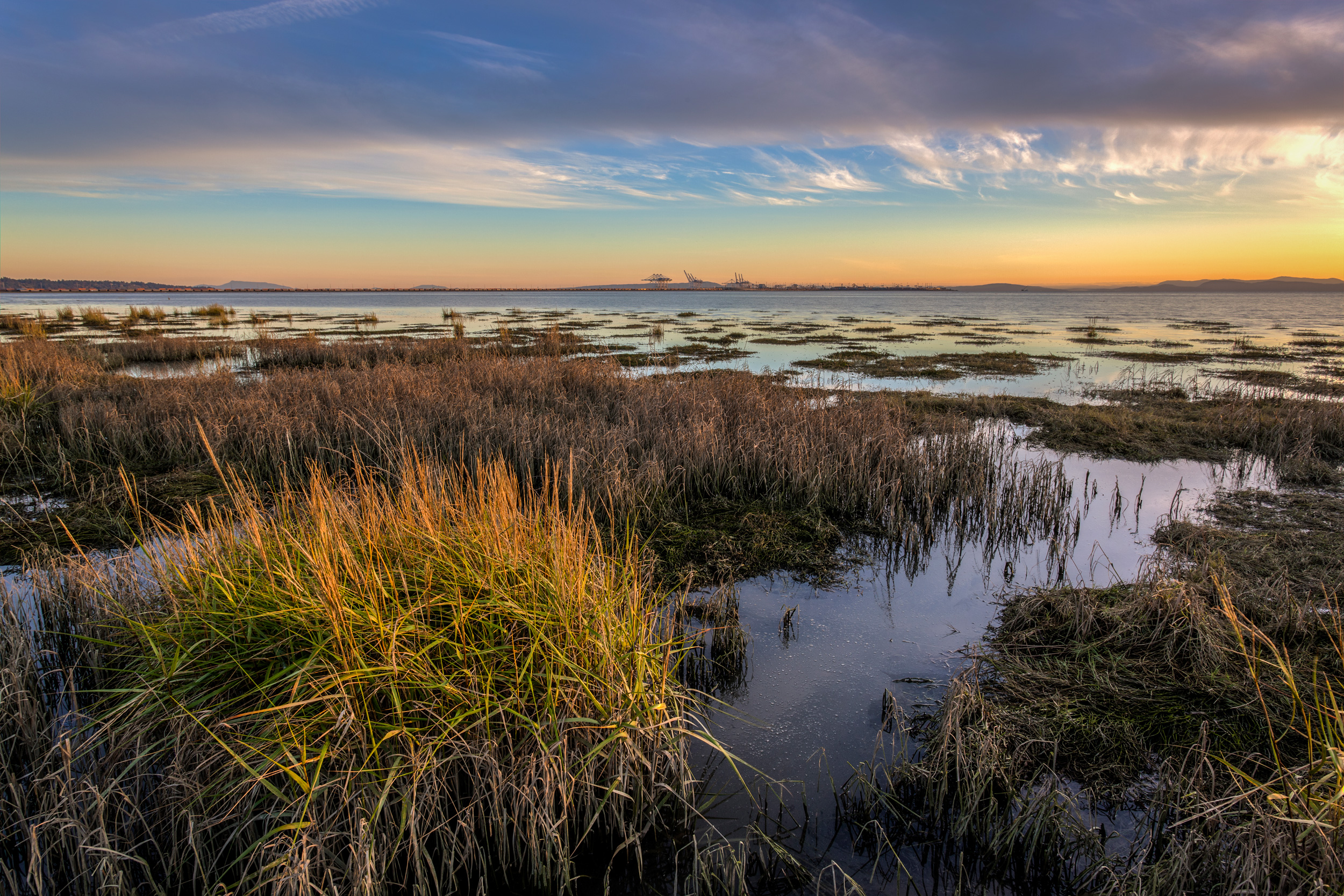
The Roberts Bank Wildlife Management Area, located just north of the Roberts Bank terminal, is a haven for migrating shorebirds and waterbirds, from geese to gulls. Photo by Ron Watts
Like many British Columbians who care deeply about protecting the environment, Emsley has little faith in the environmental assessment process and the government’s ability to protect sensitive places. Part of the problem is that in 2012, the Conservative government of former prime minister Stephen Harper overhauled—some say gutted—the Canadian Environmental Assessment Act that governs the federal process. Fish habitat protections and public consultations were rolled back.
But another key concern with the process, says Emsley, was an issue even before 2012: the use of what he calls the “captive consultants.” Much of the research carried out during environmental assessments is done by agencies or private companies, not by the government or universities, and is paid for by the proponent. And, as with Terminal 2, these agencies produce technical reports that are not subjected to the scientific gold standard: peer review. These technical reports are often the only practical way to get data in a timely fashion for a reasonable cost. But this means that project proponents are funding and designing the science underpinning the environmental assessments. “And that’s not independent, peer-reviewed science,” Emsley says. “It’s just not.”
Emsley thinks there is another, better way to get more container capacity on the British Columbia coast than by building Terminal 2. The coastal city of Prince Rupert, about 750 kilometers northwest of Vancouver, has been operating a container terminal since 2007. He thinks the expansion should go there, and he cites a report from an advisory panel submitted in 2007 to the federal government, which recommended maxing out Prince Rupert’s capacity before expanding at Deltaport, in part because of rail congestion in Metro Vancouver.
But the port rejected this recommendation, noting that some planned expansions at Prince Rupert still wouldn’t be enough. “We analyzed many alternatives to increase container capacity on Canada’s west coast,” noted Cliff Stewart, vice president of infrastructure at the port, in a statement to Hakai Magazine, “and determined that the Roberts Bank Terminal 2 project is needed, in addition to the expansion in Prince Rupert and planned improvements at existing terminals in Vancouver to deliver the capacity we need as demand for goods shipped in containers continues to grow.”
I watch Stewart make the case for Terminal 2 to the joint review panel one bright autumn day, at Simon Fraser University’s downtown Vancouver campus. I had arrived the previous day on a floatplane whose route gave me a sandpiper’s-eye view of the delta. From the air, the Fraser’s massive, muddy discharge looked like underwater clouds, suggesting that the river’s plume is as complex and dynamic as the atmosphere above. The mudflats were less a shoreline than a slow shading of land into sea. As I peered down, I could just spot the contested mud nestled beside the causeway, right beneath the port’s great cranes. It was so small.
The next day, I take notes as the panel examines the economics of Terminal 2—the financial factors the panel will weigh against the potential harm to the environment. Jocelyne Beaudet, the panel’s chair, calls the meeting to order, sporting tinted glasses and perfect white pageboy hair. A communications consultant who has served on several previous joint review panels, she conducts the proceedings in a precise French accent. Today is the second public orientation session, where interested parties can apply to present information to the joint review panel before it makes its report. The report will assist the minister of Environment and Climate Change Canada in making a final decision on whether to give Terminal 2 environmental approval.
The Port of Vancouver is one of those interested parties, and Stewart speaks for it. He’s a big man with a friendly face and voice. He explains the port’s operations and the history of container shipping, and segues easily into a discussion that addresses a key criticism of Emsley’s and other port expansion opponents—that many of the containers leaving the port are empty. Stewart explains that arriving containers hold clothing, furniture, and electronics, each container averaging about 15 tonnes. But the products we send back to Asia—lumber, wood pulp, vegetables—are heavier, closer to 25 tonnes per container.
“Put another way, cargo weight is the limiting factor for container ships headed to Asia from Vancouver, while volume is the limiting factor on ships destined for Vancouver from Asia,” Stewart says. Ships leaving Vancouver load up as much as they can, and then top up with empty containers.

In certain areas of the Roberts Bank mudflats, a slippery, shimmering goo known as biofilm forms. It is a favored food of western sandpipers, offering essential fatty acids that, among many physiological benefits, improve muscle function during the birds’ epic migrations. Ecologists worry that construction of Terminal 2 could harm this vital food supply. Photo by Ron Watts
The container business, however, is facing a period of transition. China, which has seen very rapid economic growth in recent decades, ships more than 60 percent of the containers that pass through Vancouver. But a 2016 update to a forecast study commissioned by the port states, “the outlook for the Chinese economy is considerably more uncertain than was noted in earlier forecasts.” Even so, the study’s authors suggest that Chinese trade patterns with Canada will likely remain the same, and Stewart insists that the long-term need for Terminal 2 will remain strong.
But critics aren’t convinced. “There are more and more vessels being parked because the business just isn’t there,” Emsley says. “China’s slowed down with manufacturing.”
Another emerging trend in the container business is toward much larger ships, such as the 400-meter CMA CGM Benjamin Franklin. Louanne Wong, manager of market initiatives at Global Container Terminals, which operates Deltaport, is aware of this trend. “With larger vessels, there are fewer calls and a higher volume of containers handled per call,” Wong notes by email. She says terminals don’t necessarily need more dock space. Instead, they need to reorganize their operations so that they can handle a larger “surge” of containers when a bigger ship comes calling.
The move toward bigger ships seems to weaken the case for Terminal 2. Stewart, however, stresses that the trend has increased the number of containers moving through the port by 250 percent since 2000 (even if total ship calls have only risen by about six). And the larger ships, he adds, require longer, deeper berths and larger cranes, something that Terminal 2 can accommodate.
But Stewart’s remarks infuriate opponents such as Emsley, who disputes the port’s interpretations of shipping trends. Emsley thinks if Terminal 2 goes ahead, it is likely to become a white elephant. “It’s another Mirabel,” he says, alluding to a famously underused airport built in Montreal. “I was with the airline industry at the time. The airline industry told them it was total and utter nonsense, but they didn’t listen. They went ahead and did it anyway.”
The final decision on Terminal 2 is expected in 2017 or 2018. If Catherine McKenna, the minister of Environment and Climate Change, gives the project a green light, crews could begin building the second island on Roberts Bank as early as 2018. In the meantime, widespread public scrutiny of the assessment and the process itself is likely to continue. Canada’s federal government has put the Canadian Environmental Assessment Act under review, and is conducting public consultations. Several lawsuits have been launched over the environmental assessment for the recently approved Pacific NorthWest LNG export terminal near Prince Rupert, with critics alleging that the ecological model used was inappropriate and didn’t correctly evaluate the impacts on coastal salmon habitat.
As I walk back to the floatplane terminal after the Terminal 2 joint review panel wrapped up for the day, I think about the time I spent with Rob Butler, out in the marshes of the Reifel bird sanctuary.
When I asked Butler on that outing what his most memorable bird sighting was, he thought about it for a bit, then told me it was a Chinese crested tern that he had spotted in the Matsu Islands, in the Taiwan Strait. The Chinese crested tern is a rare bird, and the East Asian-Australasian Flyway, where it migrates along with 50 million waterbirds, is in big trouble. The estuarine stops along the flyway’s chain are prime locations for development. Already, the Yellow Sea has ceded more than 50 percent of its intertidal wetlands to industrial and port development.
Asia’s social, economic, and environmental situation is not British Columbia’s. But it seems to me that as new project proposals appear along the BC coast, the western sandpiper, along with other migratory creatures such as salmon and whales, may face death by a thousand cuts if governments lack the regulatory teeth to protect them.
Even the most eloquent environmentalists often struggle to justify why a bird is worth more than a job. Butler and I discussed the topic on our walk beneath the hot August sun, his voice hinting at annoyance—perhaps because he finds the argument self-evident, perhaps because he’s tired of having to explain nature in terms of the economy. Butler is a wildlife and landscape artist as well as a scientist, and he has learned that many things are worth far more than money. “You wouldn’t do this to the National Gallery,” he says finally. “Throw out all the art and say, it’s not doing its thing.”
The young western sandpipers disappear as the afternoon wears on. The silence is almost, but not quite, complete. The port is just barely audible in the distance. It sounds just like a subway train that’s still a few stops down the tunnel.
Correction: The caption for the second-to-last photo in this story incorrectly indicated it was taken within the George C. Reifel Migratory Bird Sanctuary. It was, in fact, taken a little way south of the sanctuary.
 This article is the second in a two-part series. The first installment was “Slime, Shorebirds, and a Scientific Mystery.”
This article is the second in a two-part series. The first installment was “Slime, Shorebirds, and a Scientific Mystery.”

